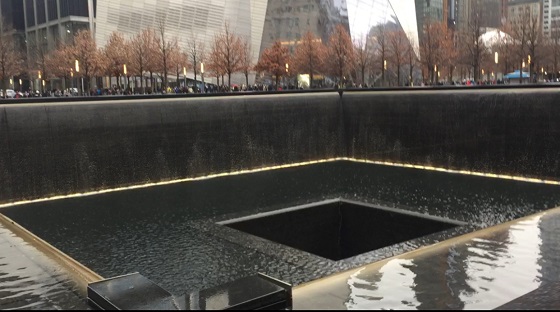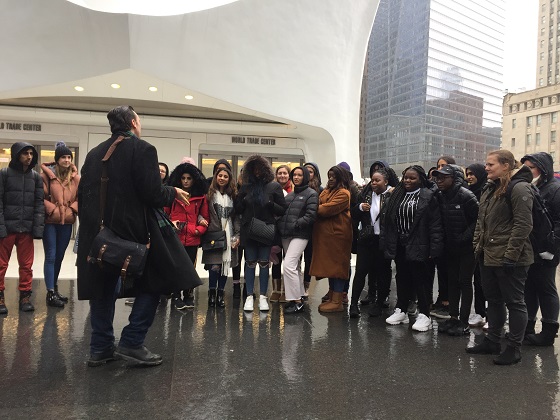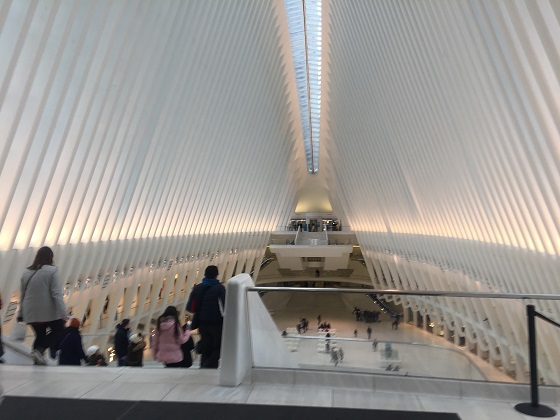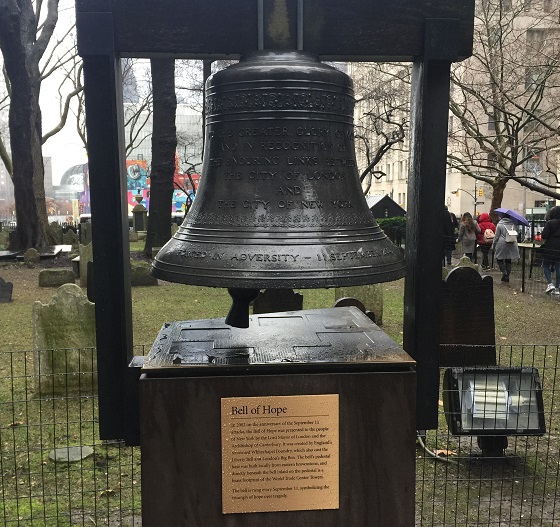It was the worst loss of life to a terrorist attack in US history, changing the collective consciousness of the nation forever.
On September 11, 2001, 19 hijackers took control of four commercial passenger jets flying out of airports on the east coast of the United States.
Two of the aircraft were deliberately flown into the Twin Towers of the World Trade Center in New York, bringing them to the ground in the space of 102 minutes and claiming close to 3,000 lives. A second flew into the Pentagon in Virginia. The fourth plane never reached its intended target, crashing in Pennsylvania.
That evening President George W Bush described the events "evil, despicable acts of terror" and said the US was "at war with a new and different kind of enemy". That war has been waged ever since.

The memorial where the South Tower once stood
The places where the Twin Towers once stood are now moving memorials to the 2,983 people who lost their lives.
So it came as no surprise that the students from DMU’s Forensic Science course – who averaged the age of three when the attacks happened – were visibly moved when they took a unique tour of the area by guide Robert Yonskie, whose father was caught up in the events of 17 years ago.
They are part of a 1,000-strong team of students who have made the journey to New York this week as part of the annual mass #DMUglobal trip to the Big Apple.
The final year students are taking part in unique educational trips relevant to their degrees as well as cultural events to broaden their horizons under DMU’s #LoveInternational banner.
The students were given a history not only of the attacks but the surrounding buildings that played a vital role in helping rebuild New York physically, mentally and spiritually.

Forensic Science students with guide Robert
They were also given details of the terrible chaos that ensued and the efforts of emergency service staff who lost their lives trying to save others.
There were also numerous insights into areas of the memorial that carried a poignancy a visitor would never normally pick up on.
Students were clearly touched by the stories of heroism that guide Robert told them about, including that of his own father who helped transport hundreds of thousands of people on boats from Manhattan when Mayor of New York Rudolph Guiliani ordered the mass evacuation of the island.
Forensic Science student Victor Man said: “It was such an incredible experience. I was particularly moved by the stories Robert told of the people he knew and the father that was caught up in the attack. I found the whole thing really touching.”

The inside of the Oculus building
Linda Bengtstrom, DMU Lecturer in Forensic Analytical Chemistry, said there was also a strong learning experience for the students to take home with them, as they prepare to start applying for their first jobs.
She said: “I really hope the students appreciate and understand the chaos that happened and how it had to be controlled during this tragic event.
“Some of the students might have to be working in disaster victim identification so I really hope that they got a feel for everything that must happen in a situation like 9/11.”
Robert said: “I would say to all students at De Montfort University that they should all be coming here to see this site and understand the rich detail that has been poured into this memorial. It really is a must for anyone visiting New York.”

The Bell of Hope outside St Paul's, Greenwich Street
Some stand-out facts from the tour:
- The Bell of Hope – The Bell of Hope was gifted to New York by the Mayor of London and the Archbishop of Canterbury. It stands outside St Paul’s – the Little Chapel – and it is rung on September 11 every year. It is also rung when terrorists carry out attacks on citizens around the world. It was rung for Manchester and the London Bridge victims. “It still rings too often”, guide Robert says.
- The Oculus building houses the transport hub for Manhattan as well as a shopping centre. Robert says some people question a shopping mall being present on a memorial site but New Yorkers are in favour of something which brings commerce and jobs to a financial district.
- The top of the Oculus opens up to the elements at 8.46am, every September 11, and remains open for 102 minutes – the time the attacks started and the length of time it took for the two towers to collapse. “For 102 minutes the centre is open and vulnerable, as we were on that day’, says Robert.
- World Trade Centre One, which replaced the Twin Towers, stands 1,776 feet tall. 1776 as the years of America’s Declaration of Independence.
- The two footprints of the Twin Towers are now the sight of two huge fountains which pour into the ground. The fountains create 2,983 fingers of water – one for every life lost in the attacks - and also represent the nation’s tears falling into a hole in the ground that never fills up.
- The fountains are surrounded by the names of every victim of 9/11. A white rose is left every day next to the name of someone who would have celebrated a birthday at that time.
- Incredibly, one tree at Ground Zero survived the 9/11 attacks. This particular pear tree was buried under 12 storeys of rubble. When the rubble was cleared it continued to flower. The average age of this particular breed of Pear Tree before it dies is 30 years. The Tree of Hope flowered again last Spring at the age of 48.
- Cuttings from the tree are gifted to any city that falls victim to a terror attack so they can grow a symbol of hope
Posted on Sunday 6 January 2019